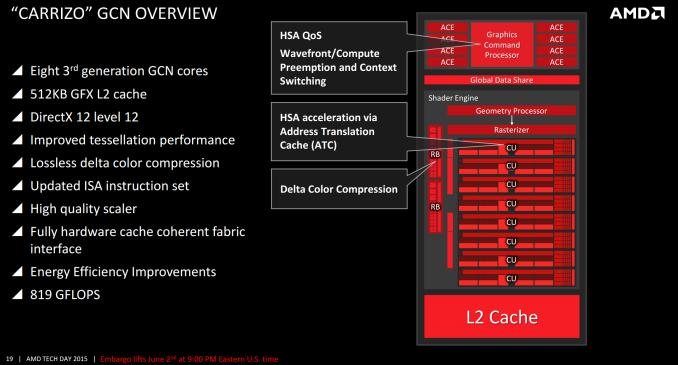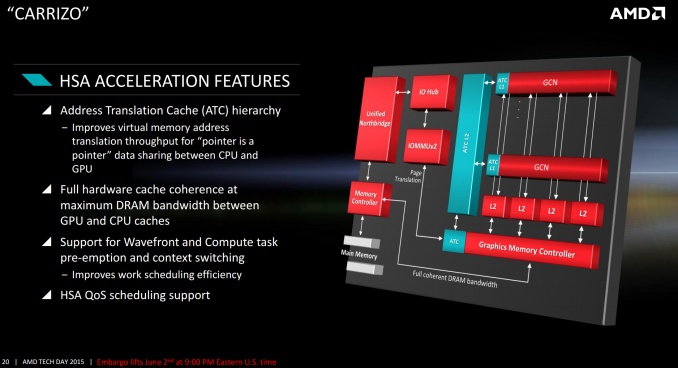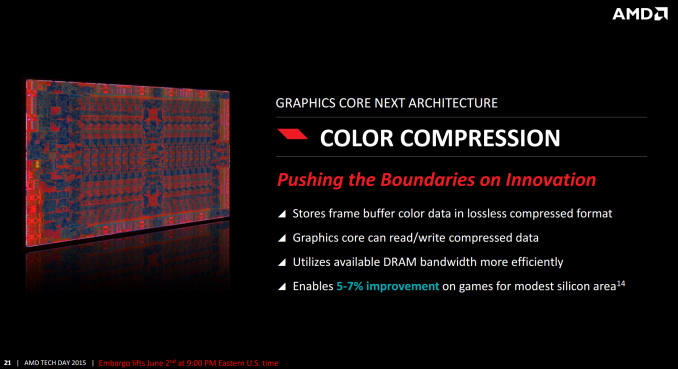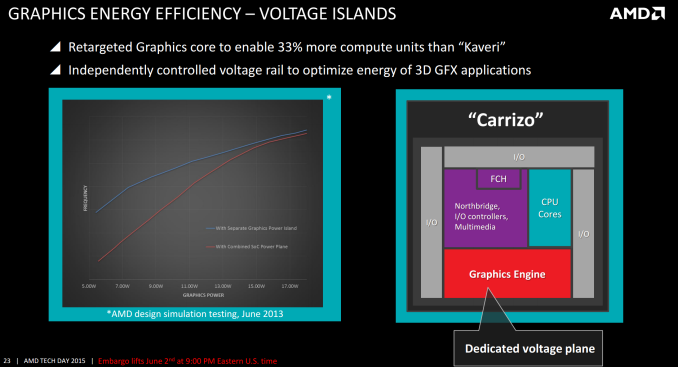AMD Launches Carrizo: The Laptop Leap of Efficiency and Architecture Updates
by Ian Cutress on June 2, 2015 9:00 PM ESTGraphics
The big upgrade in graphics for Carrizo is that the maximum number of compute units for a 15W mobile APU moves up from six (384 SPs) to eight (512 SPs), affording a 33% potential improvement. This means that the high end A10 Carrizo mobile APUs will align with the A10 Kaveri desktop APUs, although the desktop APUs will use 6x the power. Carrizo also moves to AMD’s third generation of Graphics Core Next, meaning GCN 1.2 and similar to Tonga based retail graphics cards (the R9 285).
This gives DirectX 12 support, but one of AMD’s aims with Carrizo is full HSA 1.0 support. Earlier this year when AMD first released proper Carrizo details, we were told that Carrizo will support the full HSA 1.0 draft as it currently stands as it has not been ratified, and they will not push back the launch of Carrizo until that happens. So there is a chance that Carrizo will not be certified has a fully HSA 1.0 compliant APU, but very few people are predicting major changes to the specification at this point before ratification that requires hardware adjustments.
The difference between Kaveri’s ‘HSA Ready’ and Carrizo’s ‘HSA Final’ nomenclature comes down to one main feature – context switching. Kaveri can do everything Carrizo can do, apart from this. Context switching allows the HSA device to switch between work asynchronously while it waits on the other part that needs to finish. I would imagine that if Kaveri came across work that required this, it would sit there idle waiting for work to finish before continuing, which means that Carrizo would be faster in this regard.
One of the key parts of HSA is pointer translation, allowing both the CPU and GPU to access the same memory despite their different interpretations of how the memory in the system is configured. One of the features on Carrizo will be the use of address translation caches inside the GPU, essentially keeping a record of which address points to which data and when an address is in a lower cache, that data can be accessed quicker. These ATC L1/L2 caches will be inside the compute units themselves as well as the GPU memory controller and an overriding ATC L2 beyond the regular L2 per compute unit.
Use of GCN 1.2 means that AMD can use their latest color compression algorithms with little effort – it takes a little more die area to implement (of which Excavator has more to play with than Kaveri), but affords performance improvements particularly in gaming. The texture data is stored losslessly to maintain visual fidelity, and move between graphics cores in this compressed state.
In yet more effort to suction power out of the system, the GPU will have its own dedicated voltage plane as part of the system, rather than a separate voltage island requiring its own power delivery mechanism as before. AMD’s latest numbers on the improvements here only date back to June 2013 via internal simulations, rather than an actual direct comparison.
All the performance metrics rolled in, and AMD is quoting a 65% performance improvement at 15W compared to Kaveri. The adjustment in design is allowing higher frequency for the same power, combined with the additional compute units and other enhancements for the overall score. At 35W the gain is less pronounced, but more akin to regular generational improvements anyway. What we see at 35W is what we would normally expect, and it pales in comparison to the 15W numbers.















137 Comments
View All Comments
albert89 - Monday, June 8, 2015 - link
Tell me where you can buy one for that price. Because most I see are like this article described, double the price.Prashant Jain - Wednesday, June 3, 2015 - link
Switchable Graphics is a real deal in Windows ecosystem, Linux lacks a ton of drivers and not expected to deliver more therefore AMD has scope in enterprise servers where Linux is thriving therefore AMD will succeed in long run if they somehow manage to have at par CPUs with Intel.Penti - Wednesday, June 3, 2015 - link
Switchable graphics from AMD with Intel CPU's is just so much worse than Optimus.Wolfpup - Wednesday, June 3, 2015 - link
And Optimus already doesn't work. I'm NEVER buying another PC with it, and am just thankful mine lets you disable it and run on the Nvidia GPU directly.duploxxx - Thursday, June 4, 2015 - link
well nice to hear that switchable amd graphics sucks, so does optimus. setting manual profiles is ok with optimus, i supose the same with AMD, anything automatic is NOT.oh and every time i dock - undock my explorer, chrome, firefox will crash due to graphics issues... uber optimus.
barleyguy - Wednesday, June 3, 2015 - link
Switchable graphics sucks, bad. My current work laptop is Intel/ATI, and I've also used Intel/NVidia. Neither one works as well as just a single video adapter. I've had issues with windows not refreshing, driver crashes, and just overall wonkiness.Luckily Dell lets you disable it completely in the BIOS. That tends to get rid of the issues.
RandUser - Thursday, June 4, 2015 - link
It depends. On my ASUS laptop Optimus works perfectly, no isues.Margalus - Wednesday, June 3, 2015 - link
1366x768 is perfectly fine on 15.6 inch devices...fokka - Wednesday, June 3, 2015 - link
if you're bordering on blind, yes.meacupla - Wednesday, June 3, 2015 - link
Actually, the blind and hard of seeing, benefit greatly from higher DPI with much sharper images.I wouldn't be surprised if 1366x768 caused blindness in the first place, however.